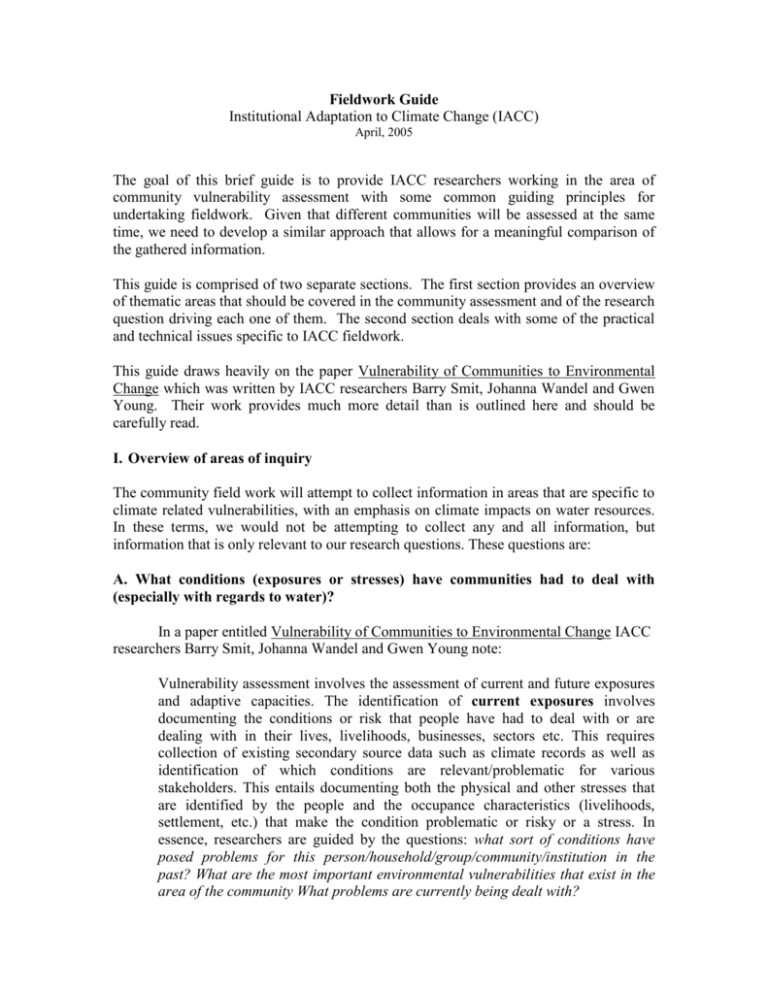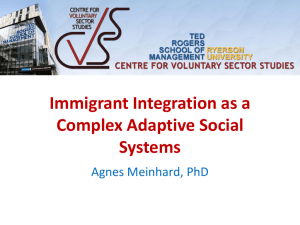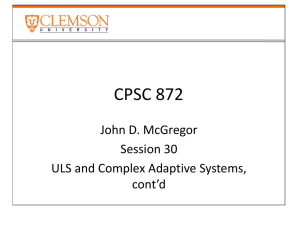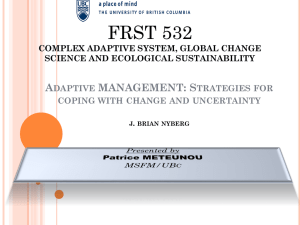Fieldwork Guide
advertisement

Fieldwork Guide Institutional Adaptation to Climate Change (IACC) April, 2005 The goal of this brief guide is to provide IACC researchers working in the area of community vulnerability assessment with some common guiding principles for undertaking fieldwork. Given that different communities will be assessed at the same time, we need to develop a similar approach that allows for a meaningful comparison of the gathered information. This guide is comprised of two separate sections. The first section provides an overview of thematic areas that should be covered in the community assessment and of the research question driving each one of them. The second section deals with some of the practical and technical issues specific to IACC fieldwork. This guide draws heavily on the paper Vulnerability of Communities to Environmental Change which was written by IACC researchers Barry Smit, Johanna Wandel and Gwen Young. Their work provides much more detail than is outlined here and should be carefully read. I. Overview of areas of inquiry The community field work will attempt to collect information in areas that are specific to climate related vulnerabilities, with an emphasis on climate impacts on water resources. In these terms, we would not be attempting to collect any and all information, but information that is only relevant to our research questions. These questions are: A. What conditions (exposures or stresses) have communities had to deal with (especially with regards to water)? In a paper entitled Vulnerability of Communities to Environmental Change IACC researchers Barry Smit, Johanna Wandel and Gwen Young note: Vulnerability assessment involves the assessment of current and future exposures and adaptive capacities. The identification of current exposures involves documenting the conditions or risk that people have had to deal with or are dealing with in their lives, livelihoods, businesses, sectors etc. This requires collection of existing secondary source data such as climate records as well as identification of which conditions are relevant/problematic for various stakeholders. This entails documenting both the physical and other stresses that are identified by the people and the occupance characteristics (livelihoods, settlement, etc.) that make the condition problematic or risky or a stress. In essence, researchers are guided by the questions: what sort of conditions have posed problems for this person/household/group/community/institution in the past? What are the most important environmental vulnerabilities that exist in the area of the community What problems are currently being dealt with? There is no doubt that the different communities under study have experienced different exposures to climate. However, even within a community different community actors will experience exposure or stress in different ways; therefore it is important to gather information from a variety of actors. Thus, it is important to understand how farmers, ranchers, town people, authorities, women, and others important community actors have experienced the impacts of these conditions or problems. To obtain an accurate understanding of how different groups experience the conditions, special effort must be made to obtain information from the members of the diversity of groups that compose the community. For instance, in the case of the condition of drought we need to gain an understanding of how a diversity of actors –and not only farmers—are directly or indirectly impacted by drought. In these terms, it is very relevant to keep in mind the recommendation of Smit, Wandel and Young regarding the need to pay attention to marginalized people, “…those who are already unable to sufficiently meet their own needs, with limited access to resources and power”. In these terms, this research question requires that we gather information about: a. Climate related conditions that have impacted the community in the past. b. Climate related conditions that have a current impact upon the community. c. The most important physical vulnerabilities in the area of the community. d. How different community actors have been impacted by these conditions B. How have communities dealt with those conditions identified (institutionally and individually)? Again drawing on Barry Smit, Johanna Wandel and Gwen Young: Assessing current adaptive capacity involves identifying the ways in which the community deals with exposures. The goal here is to answer the questions, how have individuals/households/groups/institutions dealt with/coped with/managed/adapted to the problematic conditions of the past? What adaptations or adaptive strategies were employed, how, why, by whom, under what circumstances? How are problematic conditions currently being dealt with? How effective or otherwise are current strategies? What are current barriers and enabling factors for management of problematic conditions? It must be remembered that assessing current adaptive capacity means assessing capacities, since different community members have differential access to resources and powers and thus capacity is not uniform. In these terms, it is important to keep in mind the relevance to gather information from different community actors, including the most marginalized groups. Communities use a variety of mechanisms to cope with climate related conditions. They are not restricted only to financial resources or technologies. There are also a variety of social adaptive mechanisms that have been already identified in the fields of rural studies and social capital and which could be very relevant to our community vulnerability assessment. These mechanisms are mainly two: 1. 2. Family strategies. The concept of family strategies, also called “household strategies” or “survival strategies”, was developed in the 1980s to facilitate the analysis of how social actors – such as families and households – adopt specific norms and behaviors in order to assure their own reproduction or survival. The concept has been extensively used in the field of rural studies to explain how farm families face drastic changes, such as the structural transformation of regional farming and agriculture. There is a whole issue of Sociologia Ruralis (Vol. 19, No. 3, 1986) focused on survival strategies among European farmers. Demografia y Economia –a well known Mexican journal—has also an issue dedicated to the concept (Vol. XV, No. 2, 1981). A specific form of these strategies are “networks of solidarity”: social networks centered on the exchange of goods and services among households. They are normally based on friendship and kinship and used for a variety of exchanges, from simple services to financial and machinery transfers. For the Canadian case see Diaz, H. and P. Gingrich, “Crisis and Community in Rural Saskatchewan”, in D. Hay and G. Basran (eds.) Rural Sociology in Canada, Oxford University Press: Toronto, 1992. Social capital. Adger has emphasized the role of social capital as an adaptive capacity, arguing that this form of capital is an important element for coping with climate variability and hazard. His arguments are found in his articles “Social Aspects of Adaptive Capacity” in Smith, J., R. Klein, and S. Huq, eds., 2003, Climate Change, Adaptive Capacity and Development, Imperial College Press: London; and “Social Capital and Climate Change”, Working Paper 8, Tyndall Centre for Climate Change Research. In these terms, this research question requires that we gather information about: a. The different adaptive strategies used by different community actors. b. The components of these adaptive strategies (participants and resources --technologies, capital, networks, social contacts, and others). c. The reasons why some strategies are more important than others d. The evaluation that actors make of these specific adaptive strategies. C. What issues constrained or facilitated the ability of the community to deal with (manage, cope, adapt) to the conditions previously identified? Barry Smit, Johanna Wandel and Gwen Young address this: Furthermore, assessing current adaptive management requires an identification of the broader conditions that constrain or facilitate adaptive initiatives. This introduces the questions: If there have been measures or policies or other forms of institutional support that helped deal with exposures, what were the conditions that made them feasible and effective? Are there needs and opportunities not realized? Not all adaptive strategies will be at the scale of the community (ie. internal to the community). While some adaptive strategies/capacities exist only at the level of the community, others are institutionalized at a larger level and beyond the (perceived or real) control of community members, and this influences how responses to the questions are followed up upon. For example, a need or opportunity not realized could be the resolution of a transboundary water rights issue which would result in more equitable distribution of available water, but inter-regional or inter-national water negotiations are beyond the scope of community actors. Here we need to gain information as to how the different social actors in the community identify the roles of different institutions in helping them to deal with the identified conditions. That is, the identification of the capacity of formal institutions to provide or not provide help. In these terms, this research question requires that we gather information about: a. the external institutions that different actors consider to be most relevant in terms of helping them to deal with climate-related conditions and the reasons for considering them relevant. b. The types of support that different actors expect from different institutions c. Their assessment of the capacity of these institutions to provide that support D. What is the foreseen capacity of the community to deal with possible changes in the future? Our intent here is to gather information from the people in the communities about the ability of the current and existing adaptive capacities to deal with future changes. For example, if conditions were to become drier or if the drought was to last longer would the current capacities be able to deal with this. Thus, we are asking communities members if their internal adaptive mechanisms and the capacities of external institutions are in a condition to deal with possible future problems. In these terms, this research question requires that we gather information about: a. the assessment that people make of the variety of internal mechanism found in the community (survival strategies, technologies, participation in different organizations) to deal with more drastic climate conditions. b. the assessment of people make of the current capacity of public institutions to support the community in dealing with more drastic climate conditions. II. Practical Concerns while undertaking Fieldwork A fundamental issue in this project is to ensure a level of integration within the research team. In the context of the community vulnerability assessment, this integration could be obtained by maintaining a minimum level of communication among researchers and research assistants during the course of the fieldwork. We need to maintain a high level of integration: 1. Between researchers and research assistant(s). There should be a constant communication between the researcher and the research assistant working in the field. 2. Among research assistants. Research assistants need to have a means for weekly updates and communication so that experiences, ideas, information and problems can be discussed. This could be done in the form af e-mail or an internet message board. 3. Among researchers – researchers need to be in constant communication in order to discuss advances and challenges in the progress of research (teleconferences) Research Team E-mail addresses Community Polo Diaz harry.diaz@uregina.ca Capri, Saskatchewan – Canada Stephaniess Jeannes jeanesst@uregina.ca Alejandro Rojas arojas@interchange.ubc.ca TBA Lorenzo Magzul Sonia Salas magzul@shaw.ca scsalas@hotmail.com Diaguitas - Chile Elizabeth Jimenez Hector Luis Morales elyjimenezcortes@yahoo.c om lmorales@userena.cl TBA Roxana Espinoza Barry Smit roxes@123mail.cl bsmit@uoguelph.ca Peralillo - Chile Gwen Young gyoung@uoguelph.ca Each one of the five researchers needs to assume the responsibility of training their research assistants. As a way to support that training, we have indicated in the milestone report that ethnographic training material will be posted on the website. A group of the research team members will be acting as advisors in several areas that are pertinent to the assessment of community vulnerabilities. The following table identifies them, contact information, and their areas of expertise: Name Greg Marchildon Darrell Corkal Humbero Zavala Suren Kulshreshtha, Bruce Morito E-mail greg.marchildon@uregina.ca corkald@agr.gc.ca hzavala@userena.cl suren.kulshreshtha@usask.ca brucem@athabascau.ca Area Health Water Water Economics Values






